12 Natural Infrastructure Exploited
Key Concepts
In this chapter we will:
- Explore examples of sustainable and less sustainable use of natural resources
- Demonstrate the importance of aligning the incentives with the biophysical context
12.1 Introduction
Humanity relies on the natural environment as a resource for food, shelter, materials, recreations, like all other animal species. Humans are different from other animal species in that we have developed cumulative cultural practices to develop technology and organize activities to extract ever more resources from the natural environment. Whether this is by extracting timber from forests, growing crops, mining for minerals, using water to dispose of human waste, fly to the other side of the world to enjoy natural wonders, or use other animals for testing medical procedures. Natural infrastructure is comprised of the network of organisms and physical processes that process information and materials by capturing photons from the sun to assemble the resources we extract. We can extract more than other animals, since we have developed social, human, soft and physical infrastructures.
From a CIS perspective, it is important to recognize that natural resources can only be extracted and consumed because of our investments in other types of infrastructures. You may have heard about the term ecosystem services, which is often used in sustainability debates. It is suggested that nature provides some absolute level of services for human consumption such as plants cleaning air and filtering water, bacteria decomposing waste, bees pollinating flowers and plants, and trees protecting soil from erosion. We argue that the term ecosystem services is a misnomer and can be misleading since the natural infrastructure does not provide any services without the other types of infrastructure. One needs to have knowledge of the ecosystem, create norms and regulations to avoid overuse of resources, and have access to physical infrastructure like boats and chainsaws to extract the resources natural infrastructure creates.
In this chapter we discuss three types of natural resources that have been central to the development of sustainability science; fisheries, forestry and livestock, and discuss the interaction between different types of infrastructure for sustainable use of the natural resources. We also present a contemporary example of a more exploitative use of natural resources.
12.2 Fisheries
The Maine lobster fishery is a remarkable story of self-governance within the contemporary United States. The lobster fishery of Maine is organized into territories along most of the coast. Day-to-day fishing regulations (soft human-made infrastructure) are organized by harbor gangs. These harbor gangs are informal groups that enforce local customs. In order to fish for lobster you need to become a member of a harbor gang, which is the group of fishers who go lobstering from a single harbor (natural infrastructure). Members of this group can only set traps (hard human-made infrastructure) in the traditional territory of the harbor group. There are various fishing practices that each member is expected to obey (Figure 12.1). These practices vary from harbor to harbor. To become a member of a harbor community (a formal position) requires participation by family members in that community for several generations. People who are not born and raised in these harbor communities are considered outsiders and will have difficulty gaining the level of acceptance by the rest of the community that is required before the right to fish for lobster would be granted. In all harbor communities a person who gains a reputation for damaging others’ gear or for violating conservation laws will be severely sanctioned. For example, if a fisher goes out to collect his traps, and discovers that somebody else has put traps in the same location, he may signal that this norm violation has been noticed by taking a lobster from the trap and leaving the trap open. If violations of accepted locations of traps continue, more severe measures can be taken, such as damaging gear and cutting the traps loose.
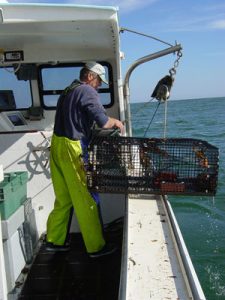
If a fisher puts traps in another gang’s territory, similar types of enforcement can be expected. The damages eventually make it unprofitable to continue breaking the informal rules, but are not so severe as to initiate a legal dispute. There are also formal laws in the state of Maine to protect the breeding stock and increase the likelihood that the regeneration rate remains high. The most important conservation laws are the minimum and maximum size measures, a prohibition against catching lobsters with eggs, and a law to prohibit the taking of lobsters which once had eggs and were marked (i.e., the V-notch law) (Figure 12.2). When a fisher collects the catch from his trap, he measures each lobster. If it is too small or too big, it will be thrown back. Such a rule avoids catching young lobsters, allowing them to mature to an age at which they will start generating offspring. If a lobster is caught that is carrying eggs, it is a productive female. The lobster will get a V-notch in the tail, and will be thrown back. This is also the case if a lobster is caught with a visible V-notch. This policy ensures that fertile female lobsters are kept alive.

Why would fishers not cheat? How could other fishers find out if a V-notched female was caught? How would they find out if a lobster that is too small was caught? It turns out that the cooperation of the middlemen (the lobster buyers) in the lobster industry is required to prevent cheating. These middlemen do not accept ineligible lobsters because their long-term financial viability depends on a productive lobster population. This gives them an incentive to help enforce the rules (by simply not buying such lobsters). Interestingly, neither the state nor any of the lobster gangs has tried to limit the quantity of lobster captured. Further, the state does not try to limit the number of lobster fishers, since this is already done at a local level. However, the state has been willing to intercede when issues exceed the scope of control of local groups. In the late 1920s, when lobster stocks were at very low levels and many local areas appear to have had compliance problems, the state took a number of steps (including threatening to close the fishery) that supported informal local enforcement efforts. By the late 1930s, compliance problems were largely resolved and stocks rebounded. Note however, that there are still too many unknowns about lobster biology to make the claim that change in management was the cause of the recovery. Figure 12.3 shows the decline of lobster catches from the 1880s until the 1930s. The absolute numbers dropped, as well as the catch per trap and per fisher. Since the 1940s the catch numbers have increased, with a rapid increase after 1990. Since the catch numbers per trap and per fisher are also increasing, this suggests that the lobster population is in good condition. If the rapid increase in total catches were caused by overharvesting we would expect a reduction in the catch per trap over time, since a decrease in the total number of available lobsters would cause an increase in the time needed to catch each lobster. Thus, each fisher would be catching fewer lobsters in a given season. But if more fishers are fishing, the total catch could remain the same, or even increase, while the stock is being depleted. These are the classic symptoms of overharvesting. Figure 12.3 shows, in fact, that the catch per trap and catch per license are actually increasing. This suggests that the lobster fishery is not being overharvested, at least at the present moment.
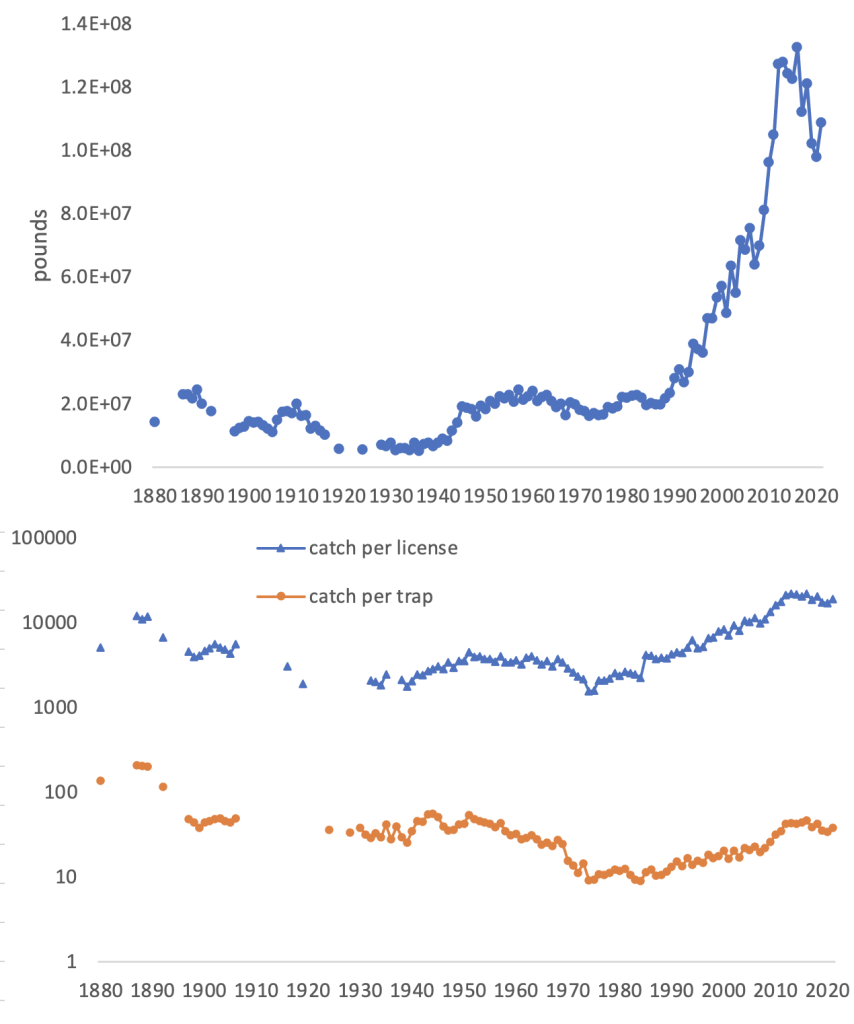
Recently, in response to changes that were breaking down the informal harbor gang system, the state has formalized the system by dividing the state into zones with democratically elected councils. Each council has been given authority over rules that have principally local impacts—trap limits, days and times fished, and so forth. Interestingly, the formalization of local zones was followed almost immediately by the creation of an informal council of councils to address problems at a greater than local scale.
The success story of Maine lobster fisheries is in stark contrast to the state of fisheries in general, and ocean fisheries in particular. The Food and Agricultural Organization of the United Nations (FAO) published a state of the world fisheries and aquaculture report in 2020 which shows an increase amount of capture of fish. Fish consumption has increased from 9 kg in 1961 to 20.5 kg in 2018. Most of the increase in fish production is caused by the increased importance of aquaculture (Figure 12.4). The natural infrastructure of marine resources shows an increased depletion over time (Figure 12.5) compensated by the creation of coupled infrastructure systems of fish production via aquaculture that are industrialized monocultures leading to the current situation in which about half of the current fish production comes from aquaculture.
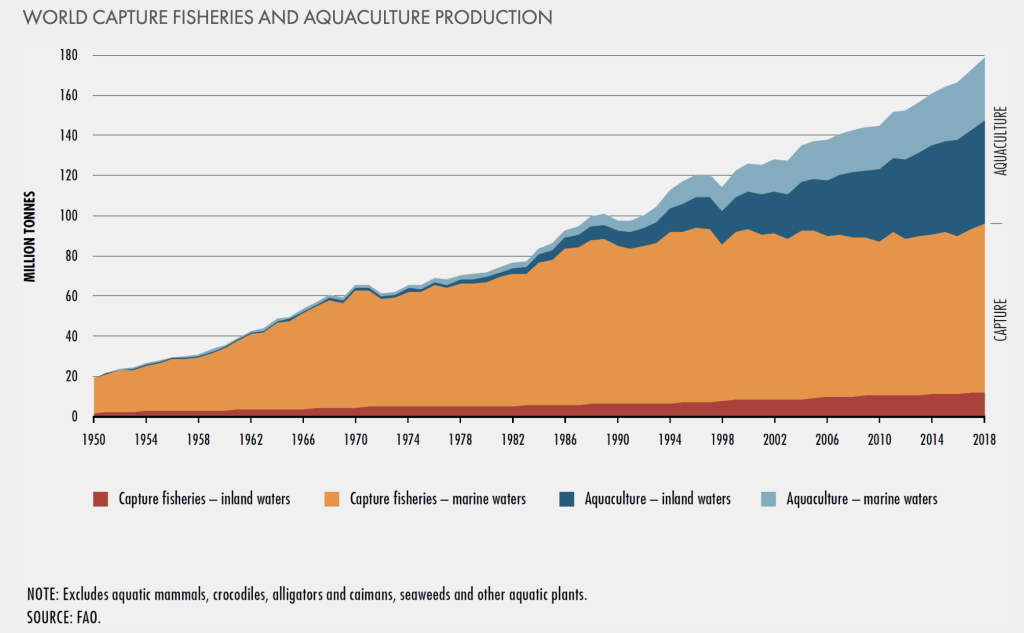
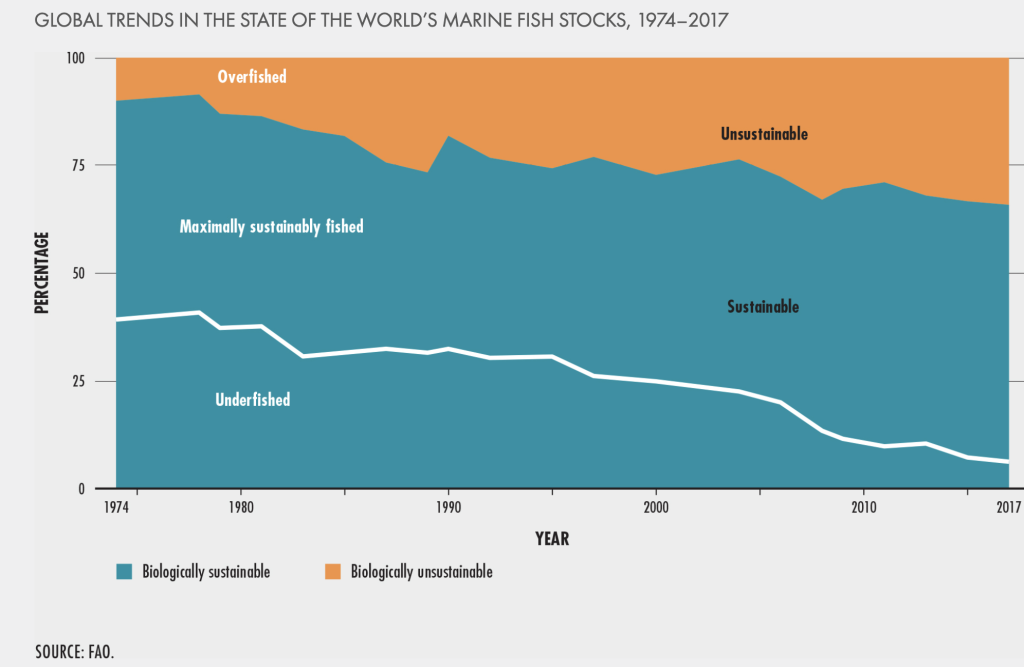
12.3 Forestry
What are effective ways to protect forests? Due to the importance of forests for biodiversity, there has been an increasing focus on creating parks and protected areas. One key concern is whether these areas are best protected by putting a fence around them or allowing human populations to continue to occupy them and help with conservation efforts. A related concern is whether designated areas become “paper parks,” i.e., areas set aside for protection on paper, but in practice, the lack of enforcement allows for a lot of poaching and illegal logging. Ostrom and Nagendra (2006) discuss long-term studies of land use change to test which type of management is most effective. They compared governmental, community, and private forests and found that the particular form of ownership is not important for the condition of the forests as measured by the quality and size of the trees. More important is whether boundaries have been well established in the field and are considered legitimate and whether regular monitoring and enforcement of rules related to entry and use exist (Figure 12.6).

Whether the boundaries are considered legitimate depends on whether people have lived in the protected area before or if surrounding populations have used the resources over an extended period of time. If the boundaries are considered legitimate, how can they be monitored? For example, if indigenous populations are taken out of the protected areas (as has been the approach in several cases), one also loses potential monitoring capacity and it is not uncommon to see an increase in poaching in protected areas. Rather than relying in indigenous populations, perhaps paid guards are the answer? What are the incentives facing paid guards to monitor and enforce the rules? If guards are not paid well, they might be willing to accept bribes and not bother those who harvest illegally. This has also been observed frequently.
Community forests (as opposed to those run by the state with paid monitoring and sanctioning) can be effective since the population who benefits most from protecting the forests also monitors their use. In this case, because the cost of monitoring is aligned with its benefits, there is an incentive for high level monitoring effort, and those who are caught breaking the rules will experience social sanctions. On the other hand, community forests might be less effective in dealing with intrusion from outsiders due to lack of capacity and legal abilities to limit access (i.e., social sanctions won’t be effective on outsiders). In this case, community forest managers need the assistance of the state. This is a clear example illustrating the importance of multilevel governance. Governmental and privately owned forests can be effective if sufficient effort is made in enforcement. But they might be more prone to corrupt guards. Further, when local people do not feel a sense of ownership and participation in the process, they are less willing to assist with monitoring (hiring enough guards is prohibitively expensive). This will lead to a lack of sufficient eyes to monitor the use of the forests.
The FAO also provided a state of the forest report in 2020. The changes in the forest stock varies across continents, in some areas there is a net increase of forest, especially Asia and Europe, due to active reforestation programs. In other regions, there is deforestation due to mainly increased conversion of forests to agriculture (especially to accommodate livestock production). There is also an increase amount of fragmentation of forest impacting habitats of animals and plants, and therefore biodiversity.
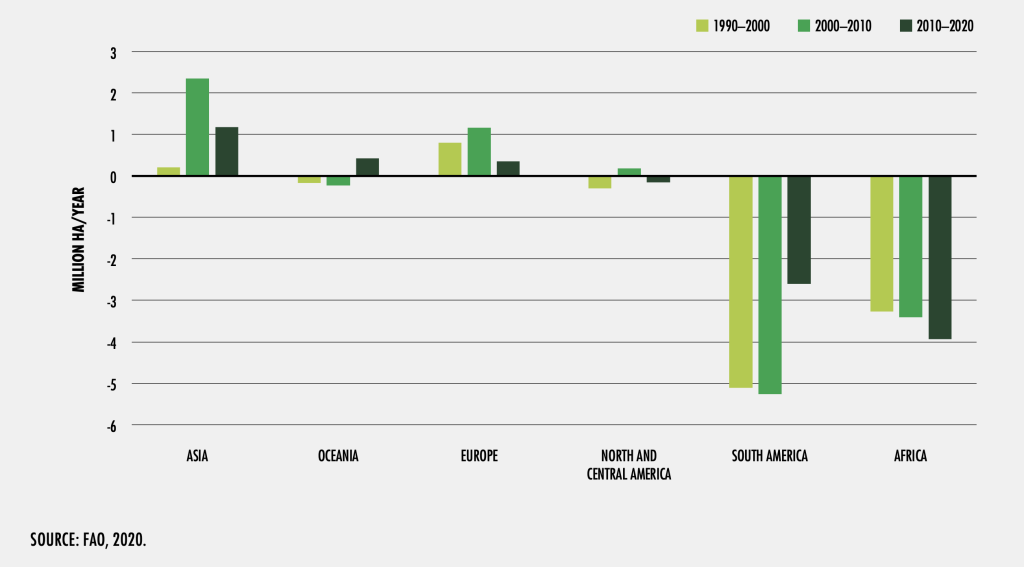
Forests are net carbon sinks, but due to large scale deforestation and climate change this can change. Gatti et al. (2021) show that the Amazon is on its way to become a net carbon emitter. Building on that report, the Economist, reports that the Amazon, the lungs of planet Earth, is tipping to a net emitter. The causes are a combination of an economic crisis leading to illegal conversion of land from forests to agriculture and a Brazilian government who is not supportive of enforcing environmental policies.
12.4 Livestock
Since meat production is one of the main causes of deforestation, we focus the last example on livestock grazing. Although nowadays a large percentage of livestock production is done at an industrial scale, historically livestock production was done in harmony with natural and social infrastructure.
Törbel, Switzerland, is a village of about 600 people located in the Vispertal trench of the upper Valais canton. For centuries, Törbel peasants have planted their privately-owned plots with bread grains, garden vegetables, fruit trees, and hay for winter fodder. Cheese produced by a small group of herdsmen, who tend village cattle pastured on the communally owned alpine meadows during the summer months, has been an important part of the local economy. The earliest known written legal documents are from 1224, and provide information regarding the types of land tenure and transfers that have occurred in the village and the rules used by the villagers to regulate the five types of communally owned properties. On February 1, 1483, Törbel residents signed articles formally establishing an association to improve the regulation of the use of the alp, the forests, and the wastelands. The law specifically forbade a foreigner (Fremde) who bought or otherwise occupied land in Törbel from acquiring any right in the communal alp, common lands, or grazing places, or permission to fell timber. Ownership of a piece of land did not automatically confer any communal right (genossenschaftliches Recht). The inhabitants currently possessing land and water rights reserved the power to decide whether an outsider should be admitted to community membership (Netting, 1976, p. 139). The boundaries of the communally-owned lands were firmly established long ago, as indicated in a 1507 inventory document.
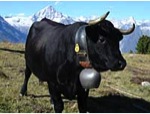
Access to this well-defined common property was limited to citizens, to whom communal rights were specifically extended. Here it is important to underscore why Hardin’s use of the term “commons” is incorrect. The alpine meadows of Törbel are “commons” (Figure 12.8) in the sense that they consist of a common-pool resource over which there are no private property rights. It is property held in common with communal rights. Thus, as we discussed previously, “commons” is not equal to “open access,” which refers to property with no rights attached. These pastures in Törbel are examples that not all “commons” end in tragedy as Hardin suggested. As far as the summer grazing pastures were concerned (the common-pool resource), regulations written in 1517 stated “no citizen could send more cows to the alp than he could feed during the winter” (Netting, 1976, p. 139). This regulation is still enforced today and provides for the imposition of substantial fines for any attempt by villagers to appropriate a larger share of grazing rights. Adherence to this “wintering” rule was administered by a local official who was authorized to levy fines on those who exceeded their quotas and to keep one-half of the fines for himself. Many other Swiss villages use the wintering rule as a means for allocating appropriation rights (frequently referred to as “cow rights”) to the commons. This and other forms of cow rights are relatively easy to monitor and enforce. The cows are all sent to the mountain to be cared for by the herdsmen. They must be counted immediately, as the number of cows each family sends is the basis for determining the amount of cheese the family will receive at the annual distribution.
The village statutes are voted on by all citizens and provide the general legal authority for an alp association to manage the alp. This association, which includes all local citizens owning cattle, holds annual meetings to discuss general rules and policies and elect officials. The officials hire the alp staff, impose fines for misuse of the common property, arrange for distribution of manure on the summer pastures, and organize the annual maintenance work, such as building and maintaining roads and paths to and on the alp and rebuilding avalanche-damaged huts. Labor contributions or fees related to the use of the meadows are usually set in proportion to the number of cattle sent by each owner. Trees that will provide timber for construction and wood for heating are marked by village officials and assigned by lot to groups of households, whose members are then authorized to enter the forests and harvest the marked trees. Private rights to land are well developed in Törbel and other Swiss villages. Most of the meadows, gardens, grain fields, and vineyards are owned by various individuals, and complex condominium-type agreements are devised for the fractional ownership among siblings and other relatives of barns, granaries, and multi story housing units. The inheritance system in Törbel ensures that all legitimate offspring share equally in the division of the private holdings of their parents and consequently in access to the commons, but family property is not divided until surviving siblings are relatively mature.
Prior to a period of population growth in the nineteenth century, and hence severe population pressure on the limited land, the level of resource use was held in check by various population-control measures such as late marriages, high rates of celibacy, long birth spacing, and considerable emigration. The Swiss villagers have experienced the advantages and disadvantages of both private and communal tenure systems for at least five centuries, and they continue to use the communal tenure system. Although the yields are low, the land in Törbel has maintained its productivity for many centuries. Netting (1976) associates five attributes to land-use patterns with the differences between communal and individual land tenure. He argues that communal forms of land tenure are better suited to the problems that appropriators face when (1) the value of production per unit of land is low, (2) the frequency of dependability of use or yield is low, (3) the possibility of improvement or intensification is low, (4) a large territory is needed for effective use, and (5) relatively large groups are required for capital-intensive activities.
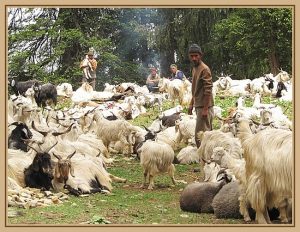
Not all owners of livestock own land, private or communal. Nomadic herders, or pastoralists, lead their livestock to graze around a large spatial landscape in order to be at the right place at the right time (Figure 12.9). In such cases, institutions have been developed to gain access to the land of various landowners. Our next example, the complex dynamics of Gaddi shepherds and their landscape in the Himachal Pradesh in India, demonstrates just such a situation. No particular place in this landscape is ideal for the maintenance of goats and sheep throughout the entire year. The only way that these animals can be cared for is to move them across a very large area with highly variable terrain. These pastoralists originally adapted their institutions to the harsh ecological conditions they faced in order to survive. They move their animals, goats, and sheep across a vast mountainous landscape within Himachal Pradesh. During the winter, they descend from the mountains and graze in the valleys and the lower elevation forests. The shepherds have made arrangements with agriculturalists (who own private plots of land) to graze on the stubble left after a harvest from private fields in return for the highly valued manure of the goats and sheep. In the summertime, it is too hot at lower elevations, so the pastoralists move into the mountains around the tree line. Lyall writes:
Snow and frost, in the high ranges, and heavy rain and heat in the low, make it impossible to carry sheep farming on a tolerably large scale with success in any part of the country. The only way is to change ground with the seasons, spending the winter in the forests in the low hills, retreating in the spring before the heat, up the sides of the snowy range, and crossing and going behind it to avoid the heavy rains in the summer (Lyall, 1872, p. 46; cited in Chakravarty-Kaul, 1998).
These seasonal movements are based on reciprocal relationships. The Gaddis shepherds invest a lot of time in social networking among themselves and with outsiders to provide access to grazing areas in return for manure and other goods and services. The informally-evolved rights of the Gaddis shepherds have never been formally recognized by the national government. In 1947, the Indian government adopted policies that reduced the shepherds’ access to the usual grazing grounds by building dams to generate hydropower and by providing strictly private property rights to farming communities. This has resulted in more concentrated areas where livestock can graze, and may have contributed to erosion in the forested hilly regions. The government has accused the Gaddis of free-riding within this commons dilemma. However, the government had not recognized the efficient system that the participants in this action situation had already worked out; in fact, the shepherds and agriculturalists had developed an effective bargaining solution by trading manure for grazing rights. The shepherds adapted to temporal and spatial variability in their system by moving around the landscape in a particular, well-ordered pattern. Activities that hinder this movement pattern on the landscape hit the vulnerable point of this transhumance system (the seasonal movement of people with their livestock between fixed summer and winter pastures). When these movement patterns are affected, the shepherds are forced to use a smaller area which may, in turn, lead to overgrazing. Thus, the transhumance system is highly tolerant to seasonal variation through very specific institutional arrangements, but is extremely vulnerable to changes in access by social or physical barriers.
Global meat consumption has increased fivefold in the last 60 years. There is a strong correlation between meat consumption and income, and when countries like China get richer, we see a rapid increase in meat consumption. To produce this meat, it is not possible to rely on traditional pastoralism or extensive livestock production. As a result, livestock production has industrialized. Animals are held in industrial complexes and provided fodder produced elsewhere (leading to deforestation). The resulting manure is typically not recycled back as natural fertilizer, but emitted to the environment leading to nitrogen emissions. Intensive livestock production is also a source of zoonotic diseases as observed in Europe and Asia, where diseases jump successfully from livestock to humans.
There are various ways to produce beef, each of which may lead to different environmental impacts. On average, beef production is the most damaging for the environment (Figure 12.10). The required land use, water consumption, and emissions make it, by far, the most damaging type of meat consumption per 100 grams of protein. The development of plant based meat alternatives could make an important contribution to reducing the environmental impact for those who do not switch to a vegan or vegetarian diet.
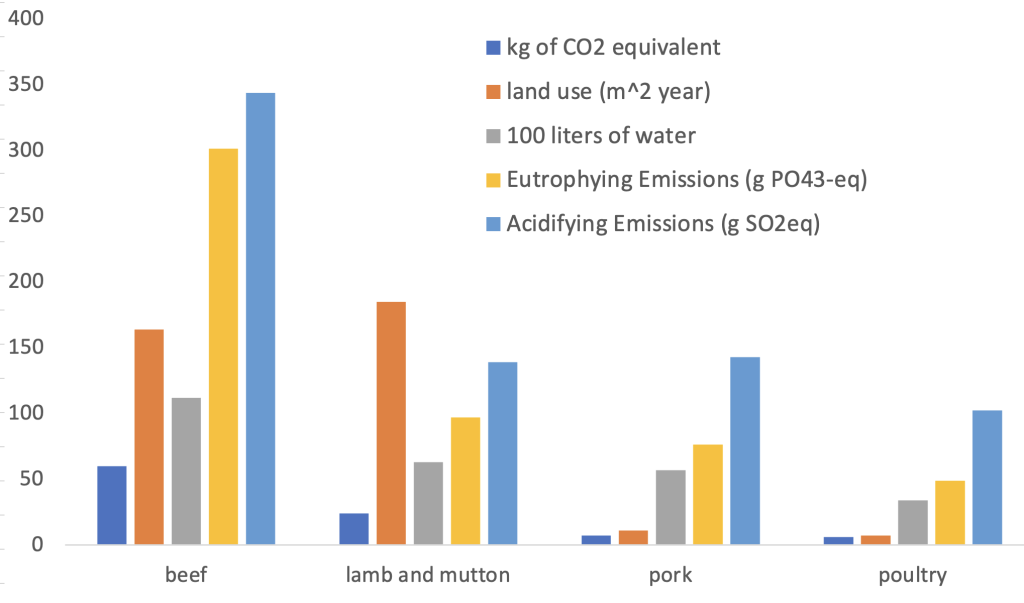
12.5 Critical reflections
There are many examples of self-organized governance of natural infrastructure that have been successful over very long time periods. In the successful examples, we see that local communities play an important role, often crafting the rules and monitoring and enforcing those rules. Hence we see major investments in social, human and soft infrastructure to govern natural infrastructure. However, with rising human populations and changing consumption patterns, we see a shift to investing in more standardized hard infrastructure decoupled from investments in fair social, human and soft infrastructure. The lower connection of the biophysical and social context to produce the affordances of the natural infrastructure, lead to more environmental impacts.
12.6 Make yourself think
1. Do you make use of public parks? What is the state of the park? What are the rules, and how are they enforced?
2. Reflect on your diet and the environmental impact of your food choices.
12.7 References
Acheson, J. M. (2003). Capturing the commons: devising institutions to manage the maine lobster industry. University Press of New England.
Chakravarty-Kaul, M. (1998). Transhumance and customary pastoral right in Himachal Pradesh: claiming the high pastures for Gaddis. Mountain Research and Development 18: 5–17.
Gatti, L.V., Basso, L.S., Miller, J.B. et al. (2021). Amazonia as a carbon source linked to deforestation and climate change. Nature 595, 388–393. https://doi.org/10.1038/s41586-021-03629-6
Lyall, F. (1872). Final report of the regular settlement of Kangra, 1868–72. Lahore, India. Government of the Punjab.
Mekonnen, M.F. and A.Y. Hoekstra (2012) A Global Assessment of the Water Footprint of Farm Animal Products, Ecosystems 15: 401-415.
Netting, R. M. (1976). What alpine peasants have in common: observations on communal tenure in a swiss village. Human Ecology 4: 135–146.
Ostrom, E. (1990). Governing the commons: the evolution of institutions for collective action. Cambridge University Press.
Ostrom, E. & Nagendra, H. (2006). Insights on linking forests, trees, and people from the air, on the ground, and in the laboratory. Proceedings of the National Academy of Sciences USA 103: 19224–19231.
Parlasca, M.C. and M. Qaim (2022) Meat Consumption and Sustainability, Annual Review of Resource Economics 14: 17-41.
Poore, J. and T. Nemecek (2018) Reducing food’s environmental impacts through producers and consumers, Science 360: 987-992.
